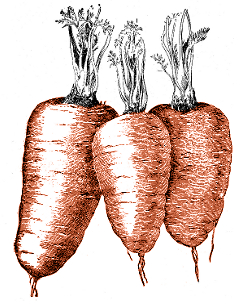Posts tagged ‘garlic’
Posted in Garden Diary, Planning, Retrospective, The Old Garden In Bristol on Saturday, September 7th 2013 (10.29 PM).
Regular readers of this site – all one of you – might have noticed that things have been rather quiet for a while here. There is, of course, a good reason for that. The reason is: the state of the garden, in the second half of last year, was such a disaster that I really didn’t feel like writing about it. I really didn’t feel like going into the garden. And so, nothing was put away for the winter, everything was left to fend for itself. A surprising amount of plants survived the winter, but the ones that did were mostly killed off by the heat earlier this summer. So now, effectively, we are starting again. The only produce we’ve had from the garden in 2013 is a small bowl from an interloper, something very tasty that we didn’t really ask for.
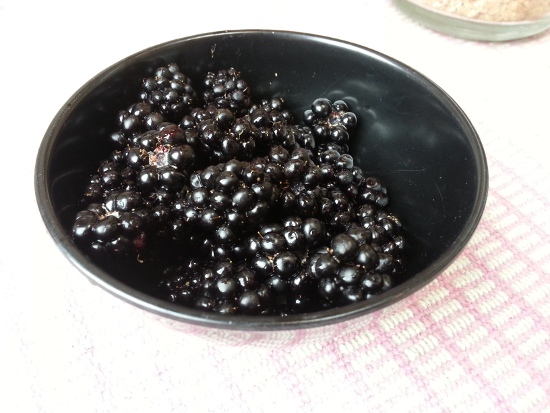
For some reason, gardening tasks always seem to end up involving brambles. I can dimly remember, aged about 5, my grandfather giving my parents a bramble shoot with the advice to keep it in a bucket lest it take over the whole garden. Naturally, by the time I had reached my teens, it had taken over, well, half the garden (the rest was lawn), and I spent what seems in memory to be most of a summer cutting it down, piece by piece, first with secateurs then with hacksaw, until my parents’ only option was to hire a wood chipper to deal with the pile of chunks. At the previous place we lived in Bristol, there was virtually no garden, and the only gardening task I ever did was regularly chop back a bramble which had managed to root itself under the decking. They really are amazing plants, in their ability to cover an area, take it over, turn everything underneath into a barren desert, and like bindweed they are endemic in this part of Bristol. So when I saw bramble runners sprouting forth over our back fence and dropping down seeking earth, I knew it had to go. After we’d eaten its fruit, of course.
The origin of the bramble is quickly explained, if we skip back to the garden plan posted a couple of years back:
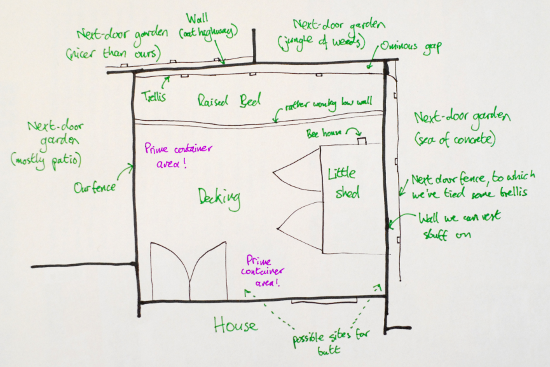
That area at top-right marked “Jungle of weeds” was all dug up about a year ago. They now have a shed, backing on to our boundary, and a high wooden fence extending off to the right. However, the cleared land on their side of said fence has been left to revert back to weediness. With their new fence, there is now double the Ominous Gap marked on the plan, and it’s this gap which has been colonised by bramble. I can reach down and chop off anything threatening to poke its way over into our space, but I have no hope at all of digging up the roots. In other words, my life is once again doomed to regularly cutting back brambles.
Apart from the bramble-hacking, what are we going to do now that we’ve admitted we’re going to restart from scratch? Try to plant things that don’t take as much nursing, for one thing, so that the garden will survive if we want a summer holiday; and things that don’t necessarily look appetising to every slug and snail in town. Lots of herbs, lots of insect-attracting flowers, and maybe the odd item of produce that we can’t easily buy here. For now, we’ve cut down the weeds that were colonising the back bed and sowed white clover for the winter, to refresh its nitrates and try to give the weeds no space to come back. Before the winter, we’ll start growing a bulb’s worth of garlic, and sow our spring flowers: of all last year’s produce, the garlic was the best harvest, and was barely touched by pests. Then, next year, hopefully things will be green again.
blackberry, bramble, clover, garlic, weeds, white clover
Posted in Garden Diary, Retrospective, The Old Garden In Bristol on Saturday, July 7th 2012 (2.50 PM).
A week ago, we passed the midpoint of the calendar year; a week or two before that, the midpoint of the solar year. A good place, I thought, to put together a little bit of a summary on how things are growing so far. With the weather, of course, it’s not going too well. There are bright spots, though. Here’s a summary, at least of the plants that are worth talking about.
- Potatoes: they’re not quite ready yet. Of the two batches of potatoes I planted, the first seem to be doing quite well. The second, though, are having problems. When I planted them, they were already far too leggy, and they stayed far too leggy as they grew. Because of that, they haven’t coped with the weather at all: they have flopped all over the place. For some reason, floppy potato plants are far more attractive to slugs and snails than tidy, well-behaved ones are.
- Green beans: the first batch were planted far too early, but happily sat in their pot for a month or two until the weather was warm enough. They’ve just reached the top of their poles, buds are starting to come, and the second batch I germinated are now ready to pot on.
- Runner beans: these went in a bit later than the green beans, and are already in full flower. They seem to be a little reluctant to set fruit, though; only one or two tiny embryo beans have been spotted so far. The standard advice for persuading beans to set seems to be “spray the flowers with water”, but given the weather I don’t really think that would help. Most of the salad leaves I planted around the base of the beans completely bolted before the weather turned wet, but some of the lettuce has been harvested and eaten.
- Garlic: also looking a bit windblown, and also not quite ready yet. They have, in the past couple of days, very quickly put forth a scape on each plant: the scapes are now safely in the fridge for eating.
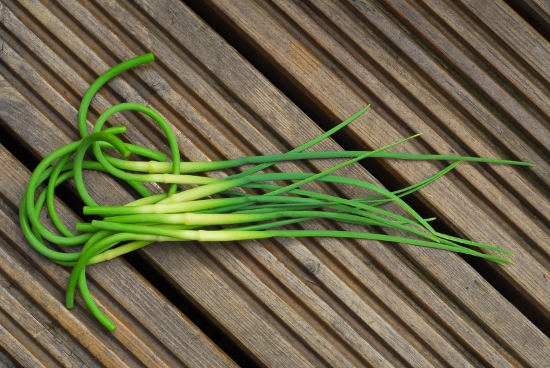
- Peas: if you ever hear anyone say to you “semi-leafless peas are self-supporting when sown in a block”, put your hands over your ears. And tape their mouth shut. And shoot them. This may be true in theory, but in reality I found that the growing peas could not cope at all with the weight of their pods. The first batch has already been harvested; and when I took them down, I could see just how twisted and serpentine the later batches have become. A final extra-big batch has been sown and planted on, spaced slightly further apart and with a lot more support provided by horizontal strings: I suspect the tight planting of the first couple of batches was the cause of the large number of pods with just two or three peas inside.
- Courgettes: the first of these were planted on about a month ago now, and seem to be doing fairly well. The first few flowers have bloomed: the problem is that with only a handful of plants, and the flowers only lasting a few days, it is difficult to get male and female flowers in bloom at the same time.
- Lemon balm: I picked these seeds up at the Bristol Seed Swap at the Cube Cinema back in February. Back in May, I put them in a pot, and waited for them to grow. Nothing happened, and I assumed something had gone wrong: all died, all rotted, all eaten by evil weevils. However, just this morning, I spotted one tiny seedling starting to emerge. Maybe it will turn out to be a lemon balm plant. So there’s a bright spot.
Writing out a list like this makes me aware of just how many different plants there are in the garden at the moment: I haven’t even had space to mention the mint; the basil mint; the peppermint; camomile; chervil; borage; French marigolds; English marigolds; cornflowers; thyme; lemon thyme; sage; rosemary; lavender; sweet peas; flat parsley; curly parsley; the fennel; or the chard. Probably best not to mention the chard at all, in fact, because I’m sure it’s a bad sign when your chard and your beans are the same height. Time to plant some more there, I think.
bean, chard, courgette, garlic, green bean, lemon balm, pea, potato, runner bean, summary, swiss chard
Posted in Garden Diary, The Old Garden In Bristol on Sunday, June 10th 2012 (10.52 PM).
We noticed last weekend that the first pods of peas looked ready for eating. You can’t make much of a meal from a couple of pods of peas, of course, so we ate the first one fresh off the plant, cracked open with my thumb and shared out in the garden.
The plants have all coped reasonably well with the past week’s bad weather. The potatoes, though, have been left rather rain-battered with a few stalks snapped off; and the garlic is looking a bit windblown. Hopefully none of this will affect what is under the ground.
garlic, pea, potato, weather
Posted in Garden Diary, Photobloggery, The Old Garden In Bristol on Tuesday, January 10th 2012 (6.23 PM).
Not very much happened the first week in January. Too cold, too damp, still too dark in the morning and evening. But the garlic has kept on coming: now with shoots up everywhere, even the cloves planted three weeks after the others. This one was, when I took the photo on Sunday, one of the furthest on:
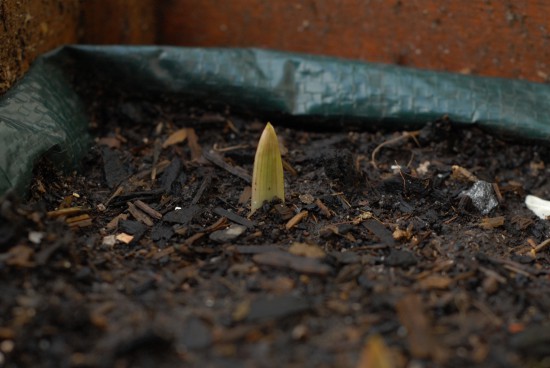
They remind me of Jason And The Argonauts: the spears of King Aeëtes’ army as his soldiers start to grow out of the earth.
garlic, germination, sprouting, winter
Posted in Garden Diary, Photobloggery, Practicalities, The Old Garden In Bristol on Monday, January 2nd 2012 (11.09 PM).
The intention, over the long Yuletide break, was to finish off tidying up the garden, clean out those remaining pots which had last year’s perennials in, and get straight on with finishing the digging of the back bed. The reality, however, was that the sofa and fireside proved too attractive.
Despite that, I have started to use one of the garden-related presents I received. From K’s sister: a garden-themed notebook.
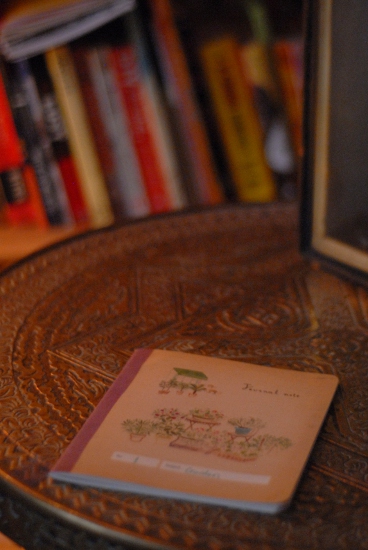
It came from Papermash, ultimately from a Korean stationery company, and inside is a normal ruled notebook; but I do love the watercolour cover. I’m going to use it as a garden diary notebook, so that I can write down what I’ve noticed when I notice it, and what I’ve done when I’ve done it, without having to come online and come here to make a note. So far it has but one entry, from last Wednesday, when I noticed the first garlic plant poking its shoot up above the surface of the soil. So far there is still only one shoot visible: I must have planted that clove rather shallower than the rest.
diary, garlic, notebook, record, recording, winter, yuletide
Posted in Garden Diary, The Old Garden In Bristol on Sunday, December 18th 2011 (8.28 PM).
The frost has really started to come in in the past week. I’m learning which parts of the garden are hit by it the hardest: the sheltered area between shed and house stays frost-free the longest, and the other side of the shed, where the bee house is, also seems to stay fairly sheltered. The middle of the garden, and the prime planting area, get hit the hardest, although so far this winter the perennial plants seem to be largely bearing up. Fingers crossed.
After I planted the garlic, three weeks ago, there were a few small cloves left over from the bulb. Today, I planted those up in the containers that, this year, we grew carrots in. The carrots – more of that free BBC seed – did not really grow very well, possibly because the containers are a little small. We will see how the garlic does: we’re starting, in these containers, with the least-viable-looking cloves already, so there won’t really be any scientific conclusions we can draw from it.
The three-weeks-planted garlic hasn’t appeared above the surface yet. K says I’m being silly, looking regularly, because at this time of year it won’t break the surface for months. But, still, I keep looking to see if sprouts have appeared.
carrot, frost, garlic, planting, weather, winter
Posted in Garden Diary, Photobloggery, Practicalities, The Old Garden In Bristol on Sunday, November 27th 2011 (8.22 PM).
Today, we cut down the remaining wizened bean plants, having made sure we had saved all the potentially viable beans for sowing next spring. With the beans and their canes missing, the garden has lost all its height, and looks very empty all of a sudden. Very bare, compared to June or July.
However, the cycle goes around. In the post, the other day, a garlic bulb arrived.
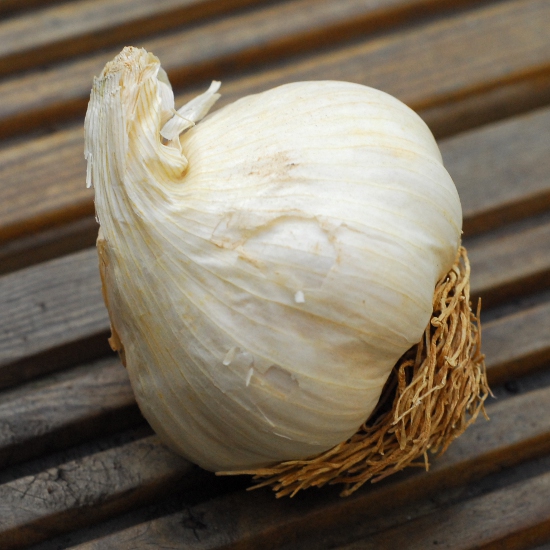
Carefully peeling off the papery skin revealed a tight-packed spiral of fat cloves.
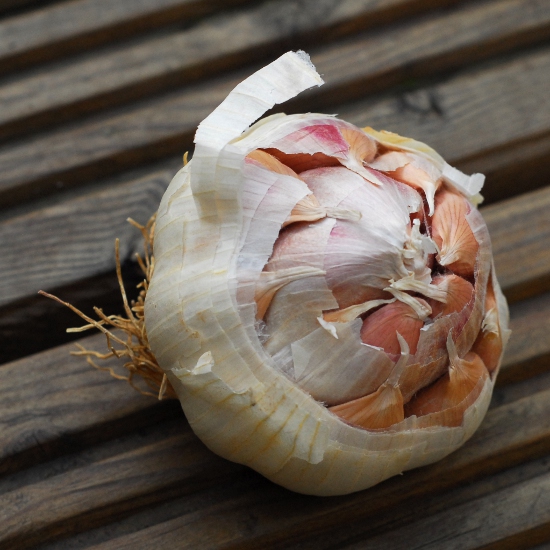
This is a softneck variety, Solent Wight, chosen because it’s meant to be a particularly easy variety to grow in southern England, as you might expect from the name. The cloves were planted up in a couple of our largest containers, moved to the sunniest side of the garden along the wall of the house; in spring a thin sprinkling of annual flower seeds might go in between the garlic stems if there looks to be enough space for them. In 8 or 9 months, if all goes well, this bulb will have turned into ten or more ready for drying and eating.
bean, garlic, green bean, planting, runner bean, solent wight, sowing



